
Welcome to the HollowLocated in the beautiful northern portion of Glacier National Park, a 1,583 square mile wilderness area located along the Rocky Mountains with glacier-carved peaks and valleys that run into and beyond the Canadian border. At its Northernmost point is an area commonly known as �Goat Haunt.� Here, a large portion of land has been sectioned off as private property, purchased by a Research Group to preserve the landscape as well as its occupants. Access to this area by visitors is strictly limited. This wild, untamed land is ruthless in nature and a sight to behold. The terrain changes vastly from deep valleys, to towering peaks, Fruitful woodlands and forests, to barren badlands and ice sheets. While the pack only occupies one area at a time based on the season, they lay claim to everything from the water�s edge, to the base of the mountains, to the edge of the most dense portion of the forest to the west and as far south as the tree line goes. Through the seasons
Spring arrives in early April but does not last very long. During this time, the remaining bits of ice and snow melt away and are replaced by new blades of grass, budding flowers and the promise of an end to the long winter months. All around the hollow life springs a new for both animals and plants. The last of the ice on the lake melts away though the water remains chilled. 
Summer spans from early June to late August, bringing the territory alive. Wild grasses grow tall and the trees provide endless shade in the warm temperatures. During these months, the territory is dotted with an array of color from blooming wild flowers and a multitude of various plant life. Despite the warmer temperatures, the lake never quite warms up. Being fed from the still snowcapped glaciers makes the lake always a tad bit chilly. 
By September, the temperatures begin to fall and as a result, foliage begins to turn fiery reds, brazen oranges and striking yellow as it all begins to fall apart, leaving the tree branches barren once more for the snows to begin. By the beginning of November, a thin sheet of ice can often be seen forming across the surface of the lake as the temperatures begin to fall. All around the Hollow animals begin preperations for winter. 
For nearly four months ice, frost and snow keep the territory nestled beneath a blanket of white until February when it all begins to melt, renewing the earth below for another Spring and causing the frozen surface to begin to thin and crack once more. The Summer HollowA large, rocky meadow at the base of a large mountain serves as the packs Summer home. The pack returns here around March, when the snows have mostly melted though bits of muck and sludge remain. Once spring arrives, wild grass grows shoulder high and large boulders that had toppled down through the decades lay scattered about.  A series of rolling hills slowly climbs upward into the steep mountainsides. A secondary cavern, similarly carved from glacial ice years ago, serves as the packs nursery for its growing young. Like the one in the Winter Hollow, this cavern is layered with grasses, foliage and furs to create a soft, warm place to sleep. However, the inside is much larger, its tall stone walls and wide area make it ideal for growing pups.  The mountain behind the Hollow remains snow caped year around, though it is the slow runoff of melting snow that flows down into a large waterfall that thunders down nearly 50 feet into the lake below. This large waterfall can be heard for miles around.  The lakeside on this end of the territory is composed of soft, fine soil that creates a gradual incline into the lake, its waters slowly lapping at the surface. For nearly 10 feet an adult wolf can walk in and not get any deeper than their elbows. This makes for a fun place for pups to splash about, if they dare to brave the chill.  A cache can be located amongst a pile of fallen boulders near the lakes front. The chill of the water keeps the earth cool enough to act as a refrigerator for the meat, keeping it lasting longer through the warm months. The Winter HollowDue to the danger of avalanches, the pack relocates from their Summer Hollow at the mountain base to a more secure area in the west, away from the mountain. The Winter Hollow is cozily nestled in a clearing tucked within the trees with the wildwoods scattered trees to the east and the denser forest to the west. .  Tucked into these rocks, a large burrow has been dug into the frozen earth about 30 yards from the lake shore. This serves as the packs Cache. The frozen earth keeping food fresh for a long period of time, while preventing the majority of it from becoming too frozen. The lake front on this end of the territory is much different from the soft soil of the Summer Hollow. Here, large flat surfaced rocks line the lake shore. Occasionally bits of water that lap at the surface remain free but sometimes a thin layer of ice will form, making the wolves work for their drink.  A short distance from the main clearing, a large hillside was once encased in ice. Over the years, the glacier around it melted carving a massive cavern into its side. Now, decades later, it makes the perfect whelping den. The tall earthen walls are frozen solid and the foliage that grows around its entrance prevents much of the weather from entering. The entrance is large, and the space within even larger. The ground is covered with discarded pelts, foliage and locks of fur of the various animals that occupied it throughout the summer while they had been away. This creates the perfect soft bedding for expectant mothers and newborn pups.  Babbling steadily just outside of the whelping den, a creek sloshes past carrying clumps of ice and slurries of snow. It wraps around the back side of the whelping den and off into the forest where a slight change in elevation causes a mini-waterfall. Not nearly as impressive as the one that feeds the lake, but as the elevation changes drastically every few feet, another tiny waterfall is created. This continues for a couple miles before evening out again.  The true treasure of the Winter Hollow lays hidden beyond the glacial hillsides. The trees begin to thin here and the badlands begin but here a series of tiny pools lay still and undisturbed, steam rising from their glassy surfaces. These hot springs provide the pack with a welcome relief from the biting cold.  Surrounding AreaTo the south of the packs territory is called the Badlands. This expanse of open land is completely bare of foliage, the hard, compacted earth making any plant life nearly impossible. Perhaps the glaciers had frozen the earth solid for too long, stripping the ground of nutrients, or perhaps a flow of lava warmed water that feeds the hot springs lay just beneath the surface, making it too warm for plant life. Whatever the case, this land is uninhabitable. No foliage, no prey. No prey, no wolves. The Rocky Mountains are raised slightly to the west, forming the border of the packs territory but rise rapidly to the North East of the Lake where they continue northward, jagged, snow caped peaks lining the horizon. These mountains slowly give way to large glaciers, one of which cuts into the landscape, butting right up against the forest to the West and North before slowly giving way to the Ice Fields, a sheet of ice that spreads out as far as the eye can see, dotted only with raised forms of other glaciers farther out on the ice. |
Text © Kladdatir WolfPack and contributors